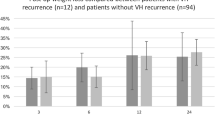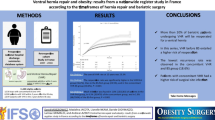Abstract
Background
Currently there is no consensus on management of ventral hernias encountered during bariatric surgery (BS). This study aims to evaluate the incidence and outcomes of concomitant ventral hernia repair (VHR) during BS at our institution.
Methods
Patients who had concomitant VHR during BS from 2004 to 2015 were identified. Data collected included baseline demographics, comorbidities, perioperative parameters, surgical approach and postoperative outcomes.
Results
A total of 159 patients underwent concomitant VHR during the study period at the time of BS. One hundred and one (64 %) patients were female; median age was 53 years (IQR 45.0–60.3) and median BMI was 48.2 kg/m2 (IQR 41.6–54.1). Comorbidities included: hypertension (n = 124, 78 %), type 2 diabetes (n = 103, 65 %), hyperlipidemia (n = 100, 63 %), obstructive sleep apnea (n = 98, 62 %) and reflux disease (n = 54, 34 %). Out of 159 patients, 41 patients (26 %) had a prior VHR. Out of 103 patients, 69 patients (67 %) had a previous abdominal surgery. Of the concomitant VHR, 144 (91 %) were completed laparoscopically, 12 (7 %) patients were converted to open surgery and 3 (2 %) patients underwent primary open procedures. Technique included primary suture closure in 115 (72 %) and mesh repair in 44. Early postoperative complications (<30 days) were reported in 16 (10 %) patients, with superficial wound infection (n = 9), bowel obstruction (n = 2), marginal ulcer (n = 2), DVT (n = 1) and pneumonia (n = 1). Hernia recurrence was reported in 3 patients (2 %) in the early post-op period and in 40 patients (25 %) as a late (>30 days) complication. Surgery for recurrent hernia was performed in 31/42 patients during follow-up. At 12-month follow-up, median BMI and % excess weight loss were 34.2 kg/m2 (IQR 29.5–40.9) and 59.6 % (IQR 44.9–74.8 %), respectively.
Conclusion
Ventral hernia is a common finding in patients undergoing BS. Both primary suture repair and mesh repair result in acceptable results, both in terms of recurrence and perioperative complications.
Similar content being viewed by others
References
Datta T, Eid G, Nahmias N, Dallal RM (2008) Management of ventral hernias during laparoscopic gastric bypass. Surg Obes Relat Dis 4:754–757. doi:10.1016/j.soard.2008.03.246
Sugerman HJ, Kellum JM, Reines HD, DeMaria EJ, Newsome HH, Lowry JW (1996) Greater risk of incisional hernia with morbidly obese than steroid-dependent patients and low recurrence with prefascial polypropylene mesh. Am J Surg 171:80–84. doi:10.1016/S0002-9610(99)80078-6
Varela JE, Hinojosa M, Nguyen N (2009) Correlations between intra-abdominal pressure and obesity-related co-morbidities. Surg Obes Relat Dis 5:524–528. doi:10.1016/j.soard.2009.04.003
Szczesny W, Bodnar M, Dabrowiecki S, Szmytkowski J, Marszałek A (2013) Histologic and immunohistochemical studies of rectus sheath in obese patients. J Surg Res 180:260–265. doi:10.1016/j.jss.2012.05.008
Klinge U, Si ZY, Zheng H, Schumpelick V, Bhardwaj RS, Klosterhalfen B (2001) Collagen I/III and matrix metalloproteinases (MMP) 1 and 13 in the fascia of patients with incisional hernias. J Invest Surg 14:47–54
Veljkovic R, Protic M, Gluhovic A, Potic Z, Milosevic Z, Stojadinovic A (2010) Prospective clinical trial of factors predicting the early development of incisional hernia after midline laparotomy. J Am Coll Surg 210:210–219. doi:10.1016/j.jamcollsurg.2009.10.013
Heniford BT, Park A, Ramshaw BJ, Voeller G (2003) Laparoscopic repair of ventral hernias: nine years’ experience with 850 consecutive hernias. Ann Surg 238:391–399. doi:10.1097/01.sla.0000086662.49499.ab (discussion 399–400)
Rao RS, Gentileschi P, Kini SU (2011) Management of ventral hernias in bariatric surgery. Surg Obes Relat Dis 7:110–116. doi:10.1016/j.soard.2010.09.021
Praveen Raj P, Senthilnathan P, Kumaravel R, Rajpandian S, Rajan PS, Anand Vijay N, Palanivelu C (2012) Concomitant laparoscopic ventral hernia mesh repair and bariatric surgery: a retrospective study from a tertiary care center. Obes Surg 22:685–689. doi:10.1007/s11695-012-0614-3
Carbonell AM, Criss CN, Cobb WS, Novitsky YW, Rosen MJ (2013) Outcomes of synthetic mesh in contaminated ventral hernia repairs. J Am Coll Surg. doi:10.1016/j.jamcollsurg.2013.07.382
Morris-Stiff GJ, Hughes LE (1998) The outcomes of nonabsorbable mesh placed within the abdominal cavity: literature review and clinical experience. J Am Coll Surg 186:352–367
Breuing K, Butler CE, Ferzoco S, Franz M, Hultman CS, Kilbridge JF, Rosen M, Silverman RP, Vargo D (2010) Incisional ventral hernias: review of the literature and recommendations regarding the grading and technique of repair. Surgery 148:544–558. doi:10.1016/j.surg.2010.01.008
Eid GM, Mattar SG, Hamad G, Cottam DR, Lord JL, Watson A, Dallal RM, Schauer PR, Dallal M (2004) Repair of ventral hernias in morbidly obese patients undergoing laparoscopic gastric bypass should not be deferred. Surg Endosc 18:207–210. doi:10.1007/s00464-003-8915-1
Chan DL, Talbot ML, Chen Z, Kwon SCM (2014) Simultaneous ventral hernia repair in bariatric surgery. ANZ J Surg 84:581–583. doi:10.1111/ans.12174
CDC—Table 7-8-9-10: SSI Guideline, 1999—HICPAC
Spaniolas K, Kasten KR, Mozer AB, Sippey ME, Chapman WHH, Pories WJ, Pender JR (2015) Synchronous Ventral Hernia Repair in Patients Undergoing Bariatric Surgery. Obes Surg 25:1864–1868. doi:10.1007/s11695-015-1625-7
Cleveland RD, Zitsch RP, Laws HL (1989) Incisional closure in morbidly obese patients. Am Surg 55:61–63
Regnard JF, Hay JM, Rea S, Fingerhut A, Flamant Y, Maillard JN (1988) Ventral incisional hernias: incidence, date of recurrence, localization and risk factors. Ital J Surg Sci 18:259–265
Mingoli A, Puggioni A, Sgarzini G, Luciani G, Corzani F, Ciccarone F, Baldassarre E, Modini C (1998) Incidence of incisional hernia following emergency abdominal surgery. Ital J Gastroenterol Hepatol 31:449–453
Pikarsky AJ, Saida Y, Yamaguchi T, Martinez S, Chen W, Weiss EG, Nogueras JJ, Wexner SD (2002) Is obesity a high-risk factor for laparoscopic colorectal surgery? Surg Endosc 16:855–858. doi:10.1007/s004640080069
Robinson SP, Hirtle M, Imbrie JZ, Moore MM (1998) The mechanics underlying laparoscopic intra-abdominal surgery for obese patients. J Laparoendosc Adv Surg Tech A 8:11–18
Newcomb WL, Polhill JL, Chen AY, Kuwada TS, Gersin KS, Getz SB, Kercher KW, Heniford BT (2008) Staged hernia repair preceded by gastric bypass for the treatment of morbidly obese patients with complex ventral hernias. Hernia 12:465–469. doi:10.1007/s10029-008-0381-1
Luján JA, Frutos MD, Hernández Q, Liron R, Cuenca JR, Valero G, Parrilla P (2004) Laparoscopic versus open gastric bypass in the treatment of morbid obesity: a randomized prospective study. Ann Surg 239:433–437
Flancbaum L, Choban PS (1998) Surgical implications of obesity. Annu Rev Med 49:215–234. doi:10.1146/annurev.med.49.1.215
Israelsson LA, Jonsson T (1997) Overweight and healing of midline incisions: the importance of suture technique. Eur J Surg 163:175–180
Hu H, Li N, Yngen M, Ostenson C-G, Wallén NH, Hjemdahl P (2004) Enhanced leukocyte-platelet cross-talk in type 1 diabetes mellitus: relationship to microangiopathy. J Thromb Haemost 2:58–64
Latham R, Lancaster AD, Covington JF, Pirolo JS, Thomas CS (2001) The association of diabetes and glucose control with surgical-site infections among cardiothoracic surgery patients. Infect Control Hosp Epidemiol 22:607–612. doi:10.1086/501830
Krinsley JS (2004) Effect of an intensive glucose management protocol on the mortality of critically ill adult patients. Mayo Clin Proc 79:992–1000. doi:10.4065/79.8.992
Rios A, Rodriguez JM, Munitiz V, Alcaraz P, Pérez D, Parrilla P (2001) Factors that affect recurrence after incisional herniorrhaphy with prosthetic material. Eur J Surg 167:855–859. doi:10.1080/11024150152717706
Stremitzer S, Bachleitner-Hofmann T, Gradl B, Gruenbeck M, Bachleitner-Hofmann B, Mittlboeck M, Bergmann M (2010) Mesh graft infection following abdominal hernia repair: risk factor evaluation and strategies of mesh graft preservation. A retrospective analysis of 476 operations. World J Surg 34:1702–1709. doi:10.1007/s00268-010-0543-z
Cozacov Y, Szomstein S, Safdie FM, Lo Menzo E, Rosenthal R (2014) Is the use of prosthetic mesh recommended in severely obese patients undergoing concomitant abdominal wall hernia repair and sleeve gastrectomy? J Am Coll Surg 218:358–362. doi:10.1016/j.jamcollsurg.2013.12.008
Kelly ME, Behrman SW (2002) The safety and efficacy of prosthetic hernia repair in clean-contaminated and contaminated wounds. Am Surg 68:524–528 (discussion 528–529)
Birolini C, Utiyama EM, Rodrigues AJ, Birolini D (2000) Elective colonic operation and prosthetic repair of incisional hernia: does contamination contraindicate abdominal wall prosthesis use? J Am Coll Surg 191:366–372
Stringer RA, Salameh JR (2005) Mesh herniorrhaphy during elective colorectal surgery. Hernia 9:26–28. doi:10.1007/s10029-004-0274-x
Schuster R, Curet MJ, Alami RS, Morton JM, Wren SM, Safadi BY (2006) Concurrent gastric bypass and repair of anterior abdominal wall hernias. Obes Surg 16:1205–1208. doi:10.1381/096089206778392374
Praveenraj P, Gomes RM, Kumar S, Senthilnathan P, Parthasarathi R, Rajapandian S, Palanivelu C (2015) Concomitant bariatric surgery with laparoscopic intra-peritoneal onlay mesh repair for recurrent ventral hernias in morbidly obese patients: an evolving standard of care. Obes Surg. doi:10.1007/s11695-015-1875-4
Raziel A, Sakran N, Szold A, Goitein D (2014) Concomitant bariatric and ventral/incisional hernia surgery in morbidly obese patients. Surg Endosc 28:1209–1212. doi:10.1007/s00464-013-3310-z
Sukeik M, Alkari B, Ammori BJ (2007) Abdominal wall hernia during laparoscopic gastric bypass: a serious consideration. Obes Surg 17:839–842
Bonatti H, Hoeller E, Kirchmayr W, Muhlmann G, Zitt M, Aigner F, Weiss H, Klaus A (2004) Ventral hernia repair in bariatric surgery. Obes Surg 14:655–658. doi:10.1381/096089204323093444
Author’s contribution
Gautam Sharma was involved in study concept, data collection and analysis, abstract and manuscript writing. Mena Boules was involved in study concept, data collection and manuscript writing. Suriya Punchai was involved in study concept and data collection. Andrew Strong was involved in data collection and analysis. Dvir Froylich was involved in study concept and original review. Zubaidah Nor Hanipah was involved in final review. Colin P. O’Rourke was involved in data analysis. Stacy A. Brethauer was involved in final review. John Rodriguez was involved in study concept and final review. Kevin El-Hayek was involved in study concept and final review. Matthew Kroh was involved in study concept, data analysis and final review.
Author information
Authors and Affiliations
Corresponding author
Ethics declarations
Disclosures
Gautam Sharma, Mena Boules, Suriya Punchai, Andrew Strong, Dvir Froylich, Zubaidah Nor Hanipah, Colin P. O’Rourke, Stacy A. Brethauer, John Rodriguez, Kevin El-Hayek and Matthew Kroh have no conflicts of interest or financial ties to disclose.
Additional information
An erratum to this article is available at http://dx.doi.org/10.1007/s00464-016-5237-7.
Rights and permissions
About this article
Cite this article
Sharma, G., Boules, M., Punchai, S. et al. Outcomes of concomitant ventral hernia repair performed during bariatric surgery. Surg Endosc 31, 1573–1582 (2017). https://doi.org/10.1007/s00464-016-5143-z
Received:
Accepted:
Published:
Issue Date:
DOI: https://doi.org/10.1007/s00464-016-5143-z




